EVGA GeForce GTX 670 4 GB Superclocked+ Review

Let’s take a closer look at an EVGA graphics card with twice as much video memory onboard and figure out how we might benefit from it in different operational modes and games.
Putting more memory on a graphics card is often not a real improvement but a marketing trick targeted at inexperienced users. Most often it is employed with entry-level solutions, such as GeForce GT630, which do not need more than 1 gigabyte of onboard memory for any applications they can cope with. However, this doesn’t prevent their manufacturers from installing additional memory, up to a fantastic 4 gigabytes, to make them look more attractive in the buyer’s eyes.
It’s different with top-end solutions such as Nvidia’s GeForce GTX 680 and 670 and AMD’s Radeon HD 7950 and 7970. The AMD cards have 3 gigabytes of memory by default, which seems to be quite enough, but Nvidia is already criticized for equipping its Kepler-based GeForce series products with only 2 gigabytes of GDDR5 memory. Meanwhile, the GK104 Kepler GPU can actually work with either 2 or 4 GB of memory, according to its specifications, and some manufacturers have used this opportunity. One of them is EVGA whose GeForce GTX 670 4GB Superclocked+ w-Backplate is going to be reviewed in this article.
Technical Specifications
The table below shows the technical specifications of the new EVGA GeForce GTX 670 4GB Superclocked+ w-Backplate graphics card side by side with those of a reference Nvidia GeForce GTX 670 (the differences are marked with bold font):
Packaging and Accessories
The product box is very compact for a top-end solution at 327 x 245 x 70 millimeters.
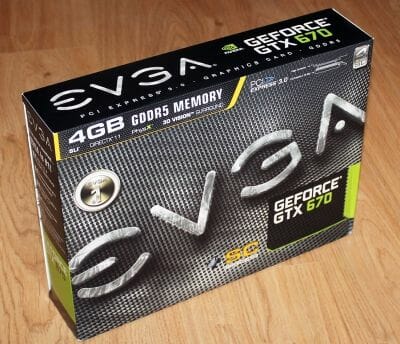
There’s product-related information on the sides of the box.
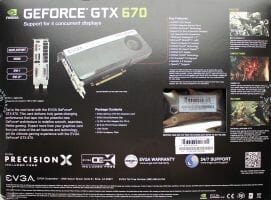
The graphics card and its accessories are laid into the compartments of a soft tray inside the box.
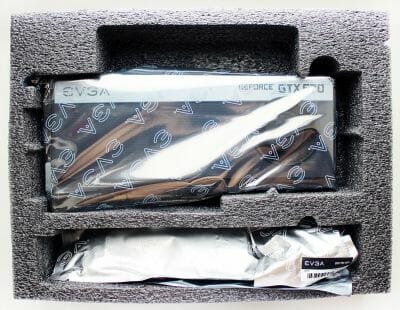
The accessories include two power adapters (two PATA connectors -> one 6-pin connector), a DVI-to-D-Sub adapter, user manuals, stickers, and a CD with drivers and utilities.
The EVGA GeForce GTX 670 4GB Superclocked is manufactured in China and costs $459, which is $60 higher than the recommended price of the regular GeForce GTX 670 with 2 GB of onboard memory. The product is shipped with a 3-year warranty but you need to register at the official website to activate it.
Design and Functionality
There’s nothing extraordinary about the appearance of the new card from EVGA as it looks similar to the reference GeForce GTX 670.
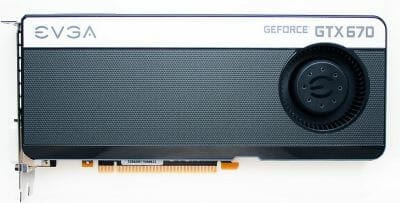
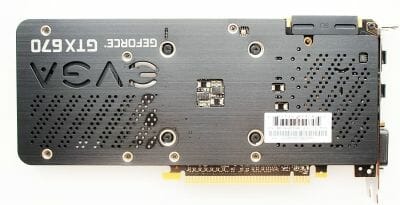
Besides some external differences such as the back-plate, the card features an originally shaped vent grid in its mounting bracket. It helps exhaust the hot air from the cooler.
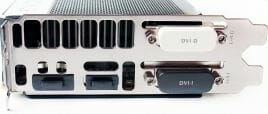
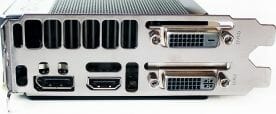
Take note that the vent grid is as large as possible. There are even vent slits above the DVI connectors. The video outputs, including dual-link DVI-I and DVI-D, HDMI and DisplayPorts, are neatly covered with rubber caps.
There are two MIO connectors (for building 2-, 3- and 4-way SLI configurations) and two 6-pin power connectors in their conventional locations on the PCB.
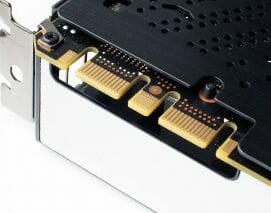
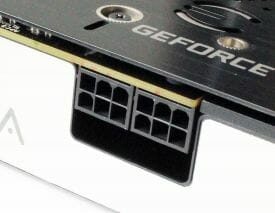
The GeForce GTX 670 is specified to have a peak power draw of 170 watts and is recommended to be used with a 500-watt power supply.
Contrary to our expectations (the card has 4 GB of memory after all!), after we removed the cooler we saw an exact copy of the reference GeForce GTX 670 PCB with a tall aluminum heatsink on the power circuit components.
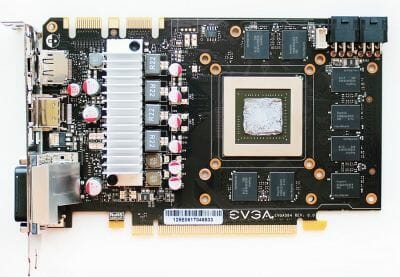
The single difference is the double amount of memory chips which are located on both sides of the PCB.
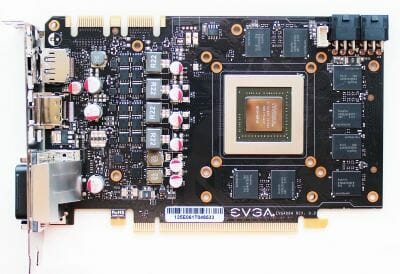
Despite that, the 4+2-phase power system (GPU+memory) is identical to the reference card’s. The 28nm GK104 chip was manufactured in Taiwan on the 15th week of 2012 (mid-April) and is revision A2 (the only revision employed on serially produced cards so far).
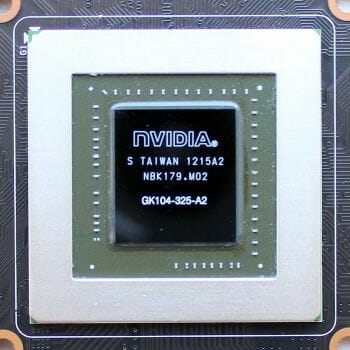
It is clocked at 967 MHz in 3D mode (boosted to 1046 MHz), which is 5.7% above the reference card’s GPU clock rate. This factory overclocking is hardly impressive. Every card in our review of three unique GeForce GTX 670s was faster by default. The clock rate is dropped to 324 MHz in 2D mode. We were lucky to get a GPU with 100% quality score, according to the latest GPU-Z:
This suggests some high overclocking potential.
The card’s 4 gigabytes of onboard memory are represented by FCBGA-packaged chips from Hynix Semiconductor which are installed on both sides of the PCB.
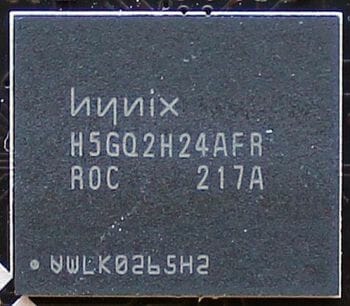
The chips are labeled H5GQ2H24AFR R0C, just like on the reference GeForce GTX 670, and have the same clock rate of 6008 MHz. They are connected via a 256-bit bus.
Here’s a summary of the EVGA GeForce GTX 670 Superclocked specs as reported by GPU-Z.
Cooling System and Temperature
The EVGA GeForce GTX 670 Superclocked being a copy of the reference GTX 670, we won’t describe its cooling system in detail. We’ve already done that in our earlier reviews and we’ve mentioned the back-plate as well.
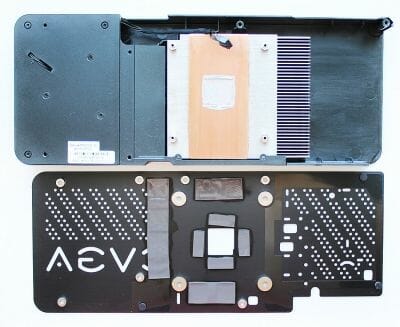
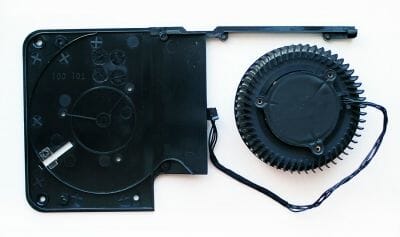
We checked out the card’s temperature while running Aliens vs. Predator (2010) five times with the highest image quality settings in 2560×1440 resolution with 16x anisotropic filtering and MSAA 4x antialiasing):
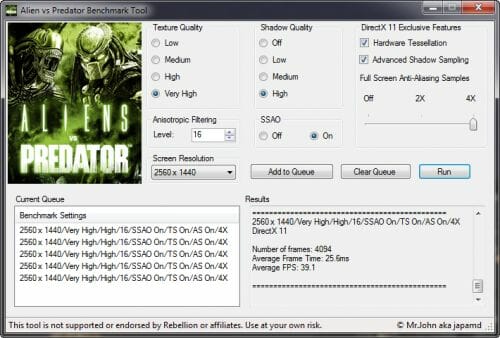
We used MSI Afterburner 2.2.2 and GPU-Z 0.6.3 as monitoring tools. This test was carried inside a closed system case at an ambient temperature of 25°C. All thermal tests were performed before we took the card apart, i.e. with its default thermal interface still intact.
Here are the results of our temperature tests:
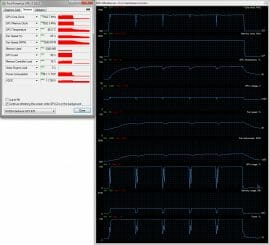
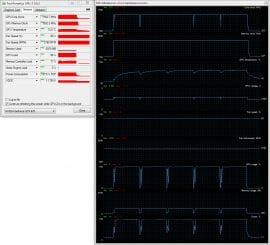
Our sample is rather hot. With the fan regulated automatically, the GPU was as hot as 86°C and the speed of the fan was 2640 RPM. At the maximum speed of 3780 RPM the GPU temperature was 73°C. We can remind you that the reference GeForce GTX 670, with a 52 MHz lower GPU clock rate, would get as hot as 81°C in the automatic mode (at 2190 RPM) and was only 65°C hot at the maximum speed of the fan (3750 RPM). Our replacing the default thermal grease with Arctic MX-4 didn’t affect the temperature of the EVGA card.
Overclocking Potential
Despite its rather high temperature and 4 gigabytes of memory, the EVGA GeForce GTX 670 Superclocked did very well in our overclockability test, being stable in most applications after we had added 150 MHz to its base GPU clock rate and 1540 MHz to its memory clock rate.
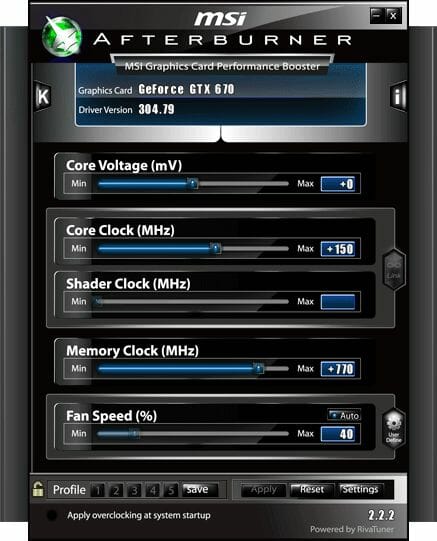
Thus, the resulting frequencies of our EVGA GeForce GTX 670 Superclocked were 1117 MHz (boosted by 79 MHz) and 7548 MHz for the GPU and memory, respectively.
Interestingly, the overclocked graphics card retained the same temperature in the automatic fan regulation mode: 86°C at 2640 RPM.
After some more testing we had to reduce the GPU and memory clock rates to 1107 and 7448 MHz, respectively, to avoid any stability issues.
Anyway, this is fantastic overclocking considering that we didn’t change the GPU’s voltage. Well, we must confess that increasing that voltage didn’t help us get better results, probably due to the insufficient efficiency of the cooling system.
Power Consumption
We measured the power consumption of our testbed equipped with different graphics cards using a multifunctional Zalman ZM-MFC3 panel, which can report how much power a computer (without the monitor) draws from a wall outlet. There were two test modes: 2D (editing documents in Microsoft Word or web surfing) and 3D (three runs of a Metro 2033: The Last Refuge benchmark in 2560×1440 resolution with maximum image quality settings).
As expected, the double amount of memory on board the EVGA card doesn’t affect its power consumption compared to the reference GeForce GTX 670. A 550-watt power supply would be quite enough for our system with an overclocked six-core CPU.
Testbed Configuration and Testing Methodology
All participating graphics cards were tested in a system with the following configuration:
- Mainboard: Intel Siler DX79SI (Intel X79 Express, LGA 2011, BIOS 0494 from 04/24/2012);
- CPU: Intel Core i7-3960X Extreme Edition, 3.3 GHz, 1.2 V, 6 x 256 KB L2, 15 MB L3 (Sandy Bridge-E, C1, 32 nm);
- CPU cooler: Phanteks PH-TC14PE (2 x 135 mm fans at 900 RPM);
- Thermal interface: ARCTIC MX-4;
- System memory: DDR3 4 x 4GB Mushkin Redline (Spec: 2133 MHz / 9-11-10-28 / 1.65 V);
- Graphics cards:
- AMD Radeon HD 7970 GHz Edition 3 GB 384 bit GDDR5, 1050/6000 MHz;
- ASUS GeForce GTX 680 DirectCU II TOP 2 GB 256 bit GDDR5, 1137/6008 MHz;
- EVGA GeForce GTX 670 Superclocked+ 2 GB 256 bit GDDR5, 967/6008 MHz and 1107/7448 MHz;
- Gigabyte GeForce GTX 670 Ultra Durable 2 GB 256 bit GDDR5, 967/6008 MHz;
- System drive: Crucial m4 256 GB SSD (SATA-III,CT256M4SSD2, BIOS v0009);
- Drive for programs and games: Western Digital VelociRaptor (300GB, SATA-II, 10000 RPM, 16MB cache, NCQ) inside Scythe Quiet Drive 3.5” HDD silencer and cooler;
- Backup drive: Samsung Ecogreen F4 HD204UI (SATA-II, 2 TB, 5400 RPM, 32 MB, NCQ);
- System case: Antec Twelve Hundred (front panel: three Noiseblocker NB-Multiframe S-Series MF12-S2 fans at 1020 RPM; back panel: two Noiseblocker NB-BlackSilentPRO PL-1 fans at 1020 RPM; top panel: standard 200 mm fan at 400 RPM);
- Control and monitoring panel: Zalman ZM-MFC3;
- Power supply: Xigmatek “No Rules Power” NRP-HC1501 1500 W (with a default 140 mm fan);
- Monitors:
- 27” Samsung S27A850D;
- 24” NEC EX231W;
- 24” NEC E231W (2 monitors).
Gigabyte GeForce GTX 670 Ultra Durable graphics card with 2 GB of memory was clocked at the same frequencies as the EVGA graphics card, so that we could compare pure performance boost from the two additional gigabytes of video memory.
In order to lower the dependence of the graphics cards performance on the overall platform speed, I overclocked our 32 nm six-core CPU with the multiplier set at 37x, BCLK frequency set at 125 MHz and “Load-Line Calibration” enabled to 4.625 GHz. The processor Vcore was increased to 1.46 V in the mainboard BIOS:
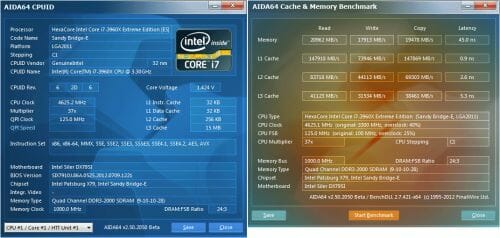
Hyper-Threading technology was enabled. 16 GB of system DDR3 memory worked at 2 GHz frequency with 9-10-10-28 timings and 1.65V voltage.
The test session started on July 25, 2012. All tests were performed in Microsoft Windows 7 Ultimate x64 SP1 with all critical updates as of that date and the following drivers:
- Intel Chipset Drivers 9.3.0.1020 WHQL from 01/26/2011 for the mainboard chipset;
- DirectX End-User Runtimes libraries from November 30, 2010;
- AMD Catalyst 12.7 beta driver from 06/25/2012 + Catalyst Application Profiles 12.7 (CAP1) for AMD based graphics cards;
- Nvidia GeForce 304.79 beta driver from 07/03/2012 for Nvidia based graphics cards.
I am sure everyone understands that it doesn’t make any sense to compare the performance of such powerful graphics accelerators in 1920×1080 resolution that is why we ran our tests in the following two resolutions: 2560×1440 and 3240×1920. The latter was set up on a triple-display configuration. The tests were performed in two image quality modes: “Quality+AF16x” – default texturing quality in the drivers with enabled 16x anisotropic filtering and “Quality+ AF16x+MSAA 4(8)x” with enabled 16x anisotropic filtering and full screen 4x or 8x antialiasing if the average framerate was high enough for comfortable gaming experience. We enabled anisotropic filtering and full-screen anti-aliasing from the game settings. If the corresponding options were missing, we changed these settings in the Control Panels of Catalyst and GeForce drivers. We also disabled Vsync there. There were no other changes in the driver settings.
The list of games and applications used in this test session includes two popular semi-synthetic benchmarking suites, one technical demo and 13 games of various genres with all updates installed as of the beginning of the test session date:
- 3DMark Vantage (DirectX 10) – version 1.0.2.1, Performance and Extreme profiles (only basic tests);
- 3DMark 2011 (DirectX 11) – version 1.0.3.0, Performance and Extreme profiles;
- Unigine Heaven Demo (DirectX 11) – version 3.0, maximum graphics quality settings, tessellation at “extreme”, AF16x, 1280×1024 resolution with MSAA and 1920×1080 with MSAA 8x;
- S.T.A.L.K.E.R.: Call of Pripyat (DirectX 11) – version 1.6.02, Enhanced Dynamic DX11 Lighting profile with all parameters manually set at their maximums, we used our custom cop03 demo on the Backwater map;
- Metro 2033: The Last Refuge (DirectX 10/11) – version 1.2, maximum graphics quality settings, official benchmark, “High” image quality settings; tesselation, DOF and MSAA4x disabled; AAA aliasing enabled, two consecutive runs of the “Frontline” scene;
- Just Cause 2 (DirectX 11) – version 1.0.0.2, maximum quality settings, Background Blur and GPU Water Simulation disabled, two consecutive runs of the “Dark Tower” demo;
- Aliens vs. Predator (2010) (DirectX 11) – Texture Quality “Very High”, Shadow Quality “High”, SSAO On, two test runs in each resolution;
- Lost Planet 2 (DirectX 11) – version 1.0, maximum graphics quality settings, motion blur enabled, performance test “B” (average in all three scenes);
- Sid Meier’s Civilization V (DirectX 11) – version 1.0.1.348, maximum graphics quality settings, two runs of the “diplomatic” benchmark including five heaviest scenes;
- Total War: Shogun 2 (DirectX 11) – version 2.0, built in benchmark (Sekigahara battle) at maximum graphics quality settings;
- Crysis 2 (DirectX 11) – version 1.9, we used Adrenaline Crysis 2 Benchmark Tool v.1.0.1.13. BETA with “Ultra High” graphics quality profile and activated HD textures, two runs of a demo recorded on “Times Square” level;
- Hard Reset Demo (DirectX 9) – benchmark built into the demo version with Ultra image quality settings, one test run;
- Batman: Arkham City (DirectX 11) – version 1.2, maximum graphics quality settings, physics disabled, two sequential runs of the benchmark built into the game.
- Battlefield 3 (DirectX 11) – version 1.4, all image quality settings set to “Ultra”, two successive runs of a scripted scene from the beginning of the “Going Hunting” mission 110 seconds long;
- DiRT Showdown (DirectX 11) – version 1.0, built-in benchmark at maximum graphics quality settings (“Ultra” preset) on the “Nevada” track.
- Sniper Elite V2 Benchmark (DirectX 11) – version 1.05, maximum graphics quality settings (“Ultra” profile), Advanced Shadows: HIGH, Ambient Occlusion: ON, Stereo 3D: OFF, two sequential test runs.
If the game allowed recording the minimal fps readings, they were also added to the charts. We ran each game test or benchmark twice and took the best result for the diagrams, but only if the difference between them didn’t exceed 1%. If it did exceed 1%, we ran the tests at least one more time to achieve repeatability of results.
Performance
3DMark Vantage
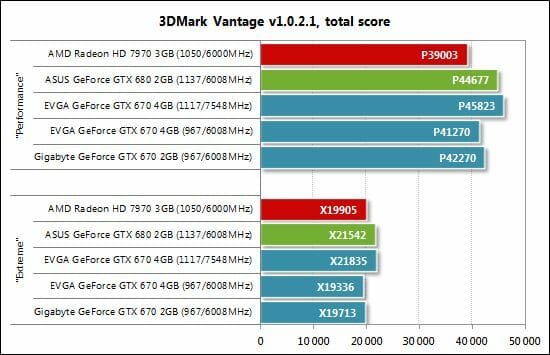
3DMark 2011
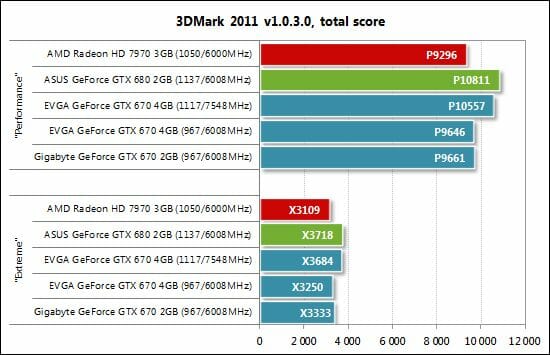
Unigine Heaven Demo
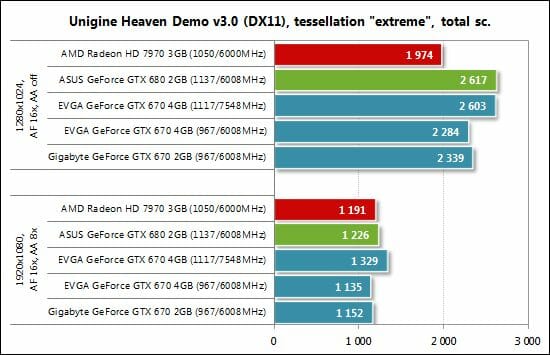
The two semi-synthetic benchmarks and Unigine demo don’t have anything new to tell us. The 4 gigabytes of graphics memory do not show up, the Gigabyte even being a little faster than the EVGA at the same clock rates. Hopefully, we’ll get more exciting results in games, especially as we’ll complement our traditional diagrams with memory usage charts at both resolutions (2560×1440 on the left and 3240×1920 on the right).
S.T.A.L.K.E.R.: Call of Pripyat
S.T.A.L.K.E.R.: Call of Pripyat isn’t a new game, yet it needs 1.1 gigabytes of graphics memory at 2560×1440 (here and in the other tests this number includes 150-200 megabytes required by the OS) when antialiasing is off. When 4x antialiasing is turned on, the number increases to 1.4 gigabytes. The resolution of 3240×1920 pixels is about 70% larger than 2560×1440 pixels, so the game needs 1.5 and 1.83 GB of graphics memory with antialiasing off and on, respectively.
Although the memory requirements are close to the limit of a regular GeForce GTX 670, the test results of the two GTX 670s are identical:
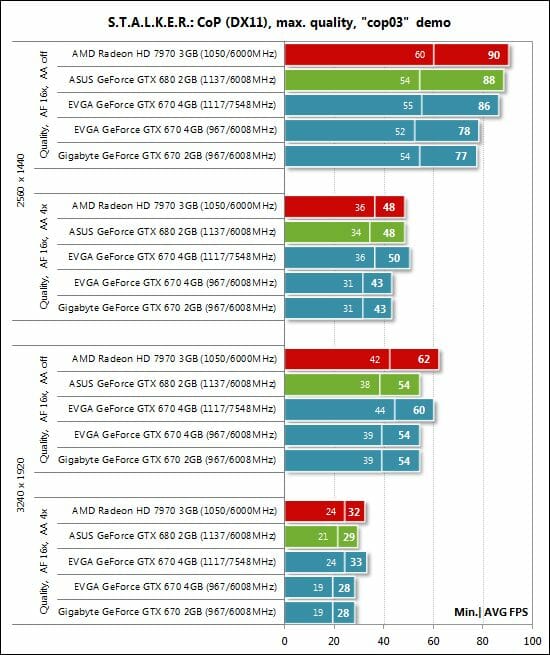
We can only add that the overclocked EVGA is easily ahead of the GeForce GTX 680 thanks to its higher memory clock rate. We’ll see the same picture in the rest of the tests.
Metro 2033: The Last Refuge
Known for its high graphics memory requirements, Metro 2033: The Last Refuge took 1.15 and 1.84 gigabytes at 2560×1440 and 1.3 and 2.55 GB at 3240×1920.
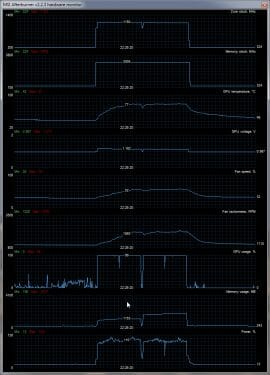
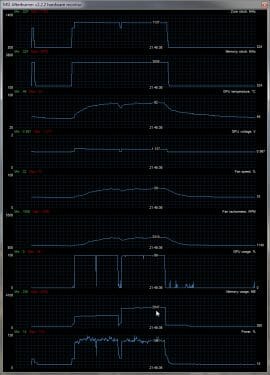
There is no difference between the two GeForce GTX 670s at 2560×1440 but we see it as soon as we switch to 3240×1920.
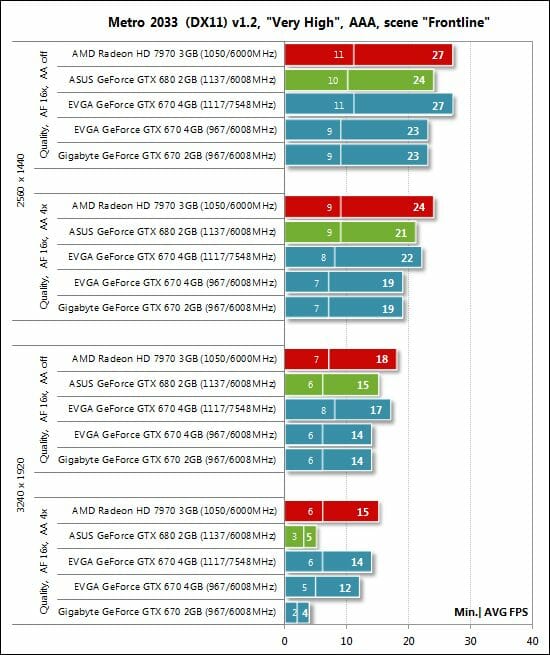
The EVGA GeForce GTX 670 Superclocked with 4 GB of memory is three times as fast as the regular GeForce GTX 670 and twice as fast as the overclocked GeForce GTX 680. That would be perfect if its frame rate were not as low as 14-15 fps, bottoming out to 5-6 fps. Of course, there’s no talking about smooth gameplay at such a low speed. Still, we can note that the double amount of memory does provide some benefits here.
Just Cause 2
Just Cause 2 has a modest appetite, consuming no more than 1.2 gigabytes of graphics memory (at 3240×1920 with 8x MSAA):
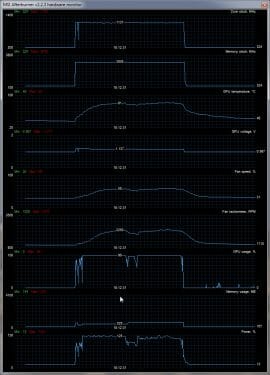
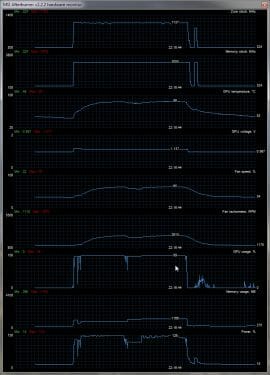
So, we can’t expect to get unusual results:
Yet we can note that the EVGA is ahead of the Gigabyte with our triple-monitor configuration while the Gigabyte is a little faster at 2560×1440.
Aliens vs. Predator (2010)
This game needs 0.9 and 1.3 GB of graphics memory at 2560×1440. Its appetite grows to 1.2 and 1.66 GB at 3240×1920.
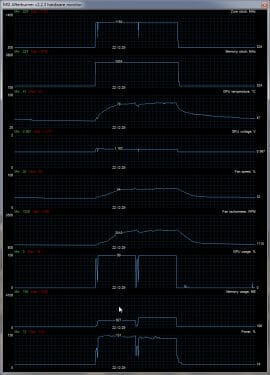
Every graphics card in this test session can offer that much memory, so the double amount of memory chips on board the EVGA GeForce GTX 670 Superclocked doesn’t make it any faster.
Lost Planet 2
Lost Planet 2 is comparable to the previous game in its graphics memory requirements:
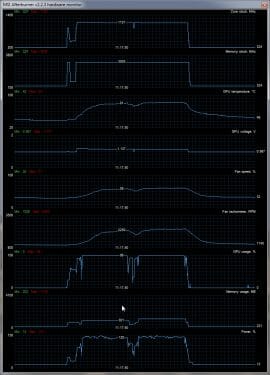
However, the 4 GB of memory add something to the performance of the EVGA card compared to the 2GB card from Gigabyte.
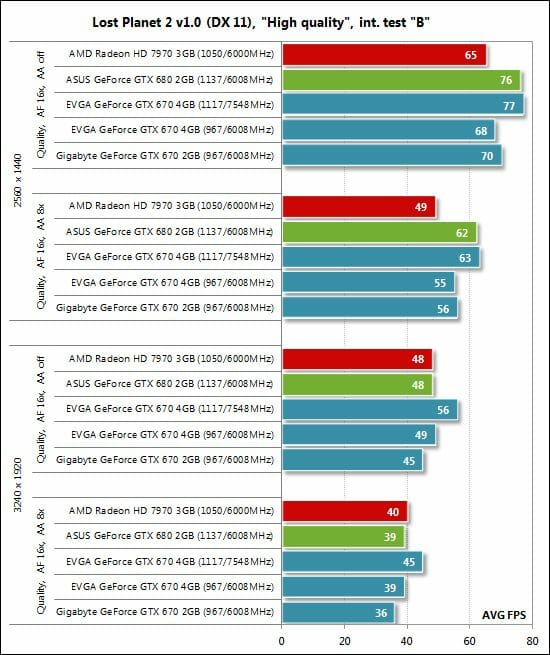
Sid Meier’s Civilization V
Sid Meier’s Civilization V needs no more than 1.3 GB of memory from the GeForce GTX 670s:
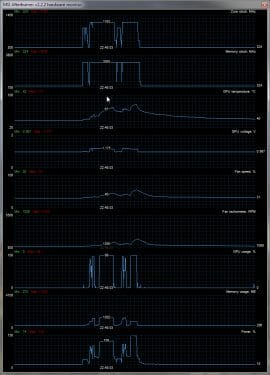
Anyway, it is the third time that the EVGA is ahead of the Gigabyte with our triple-monitor configuration. It even beats the overclocked GeForce GTX 680:
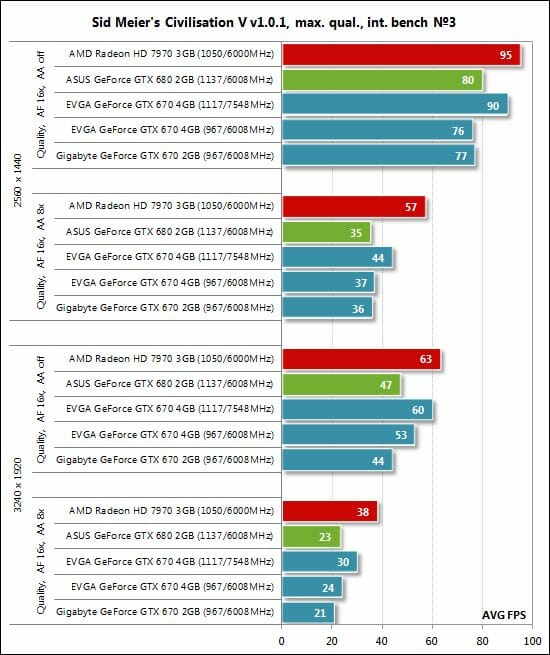
There’s no difference between the GeForce GTX 670s at 2560×1440.
Total War: Shogun 2
Surprisingly enough, Total War: Shogun 2 with its high system requirements is quite satisfied with 2 GB of graphics memory:
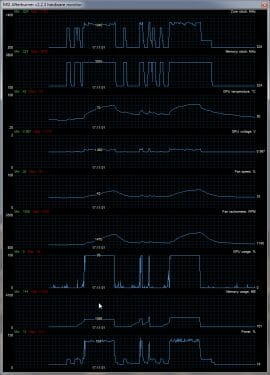
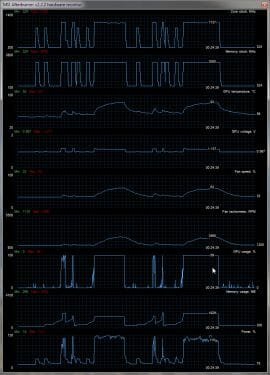
The game needs no more than 1.8 gigabytes of graphics memory on our triple-monitor configuration with a resolution of 3240×1920 pixels even if you enable 4x antialiasing. Here are the results:
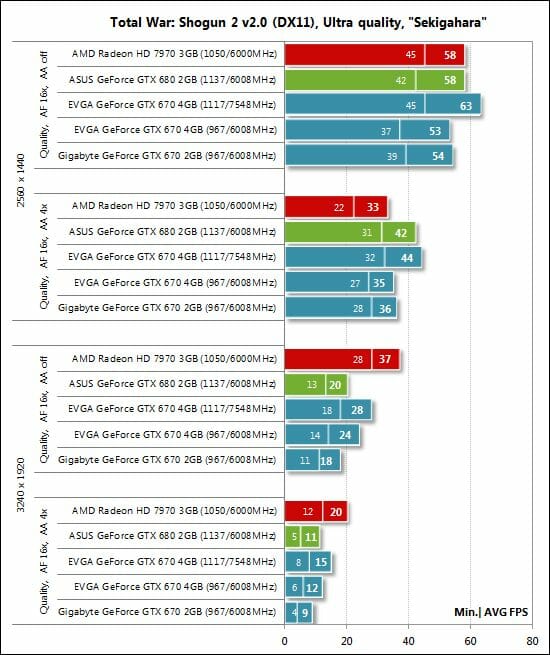
There’s no difference between the two GeForce GTX 670s at 2560×1440 but the EVGA GeForce GTX 670 Superclocked 4GB goes ahead of the Gigabyte GeForce GTX 670 Ultra Durable 2GB at 3240×1920 pixels at 3240×1920 and is even somewhat faster than the overclocked GeForce GTX 680 from ASUS. Every card is awfully slow at the highest resolution, though.
Crysis 2
Crysis 2 calls for 1.9 gigabytes of graphics memory at 2560×1440 pixels and 2.22 gigabytes at 3240×1920 pixels.
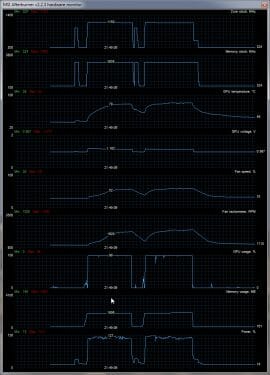
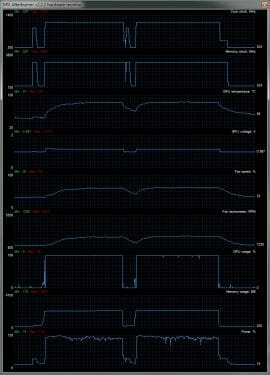
Two out of the three Nvidia-based cards might be expected to have problems here, yet it’s hard to see that.
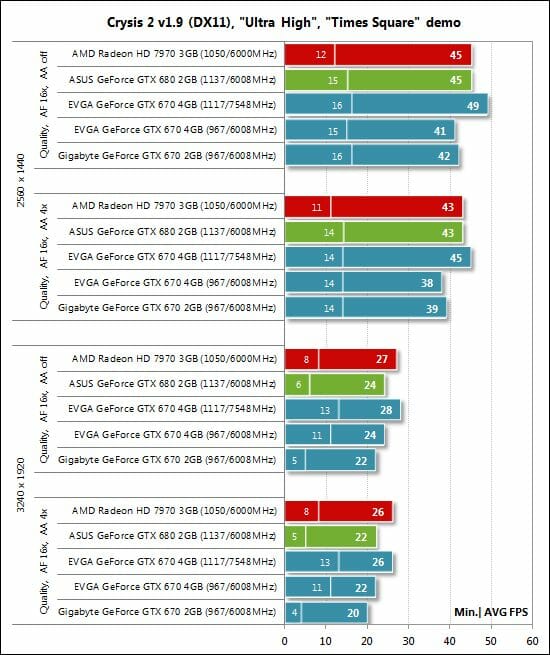
The two GeForce GTX 670s have identical results at 2560×1440, but the EVGA is again a little faster at 3240×1920. Take note of the bottom speeds: the GeForce GTX 670 with double memory amount has twice the bottom speed of the regular GTX 670 and 680. This advantage is spoiled by the overall low performance of every graphics card at that resolution, though.
Hard Reset Demo
At the highest resolution and 4x antialiasing Hard Reset needs 1.68 gigabytes of graphics memory. Its appetite is much more moderate at other settings.
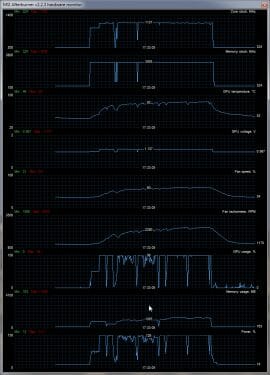
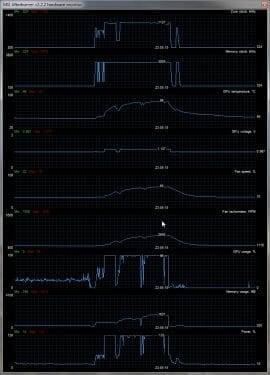
So, it is at the highest settings that our GeForce GTX 670s differ.
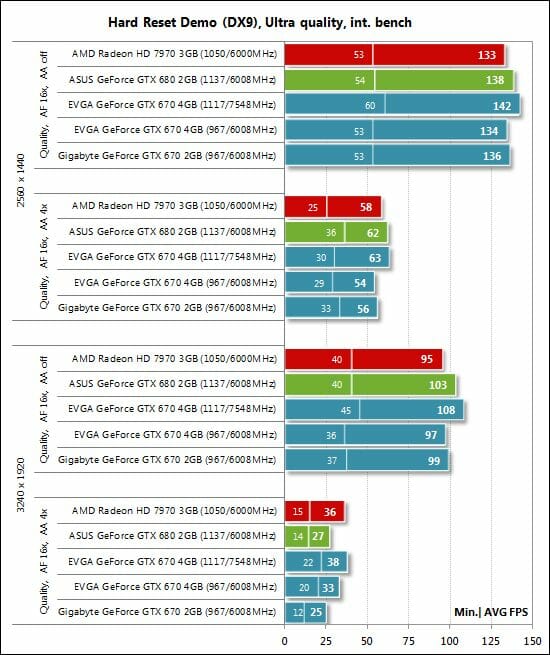
In the other three test modes the Gigabyte is slightly better than the EVGA.
Batman: Arkham City
This game needs more than 2 gigabytes of graphics memory when you run it on a triple-monitor configuration with 8x antialiasing.
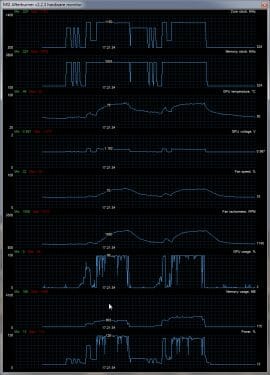
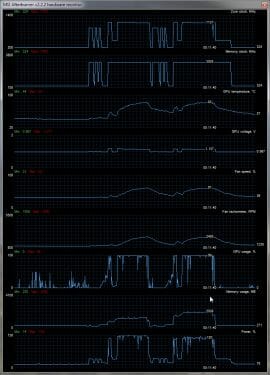
We can see this in the 3240×1920 results:
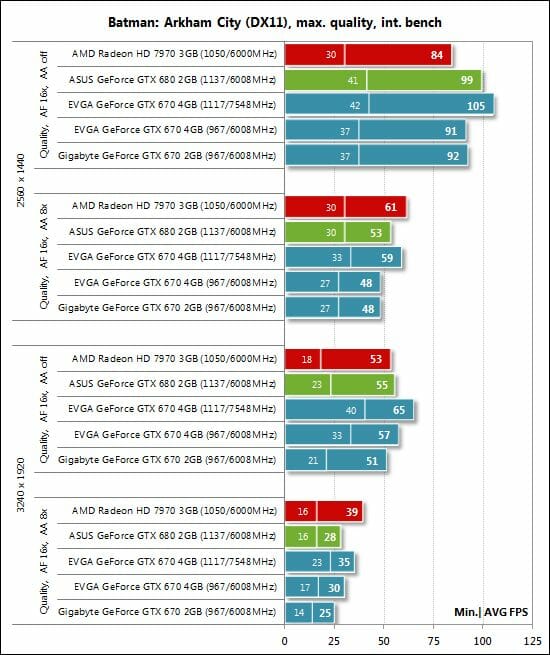
Battlefield 3
Battlefield 3 needs just a little more than 2 gigabytes of memory at the highest settings. Otherwise, 2 GB is more than enough for it.
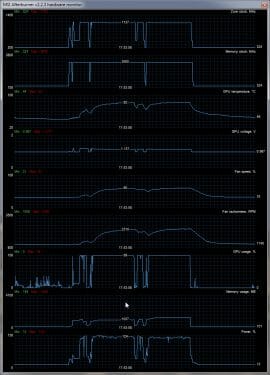
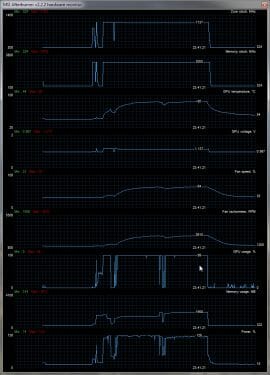
So, there’s nothing unexpected about these results:
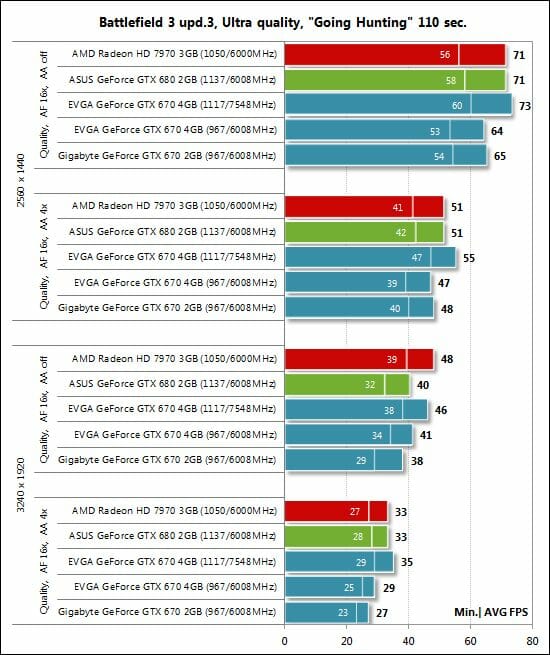
DiRT Showdown
This game needs no more than 1.5 gigabytes even if you turn on 8x MSAA.
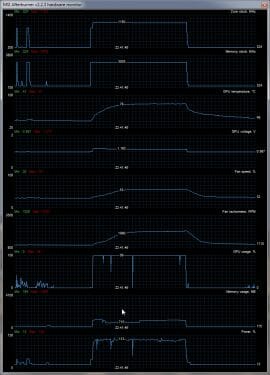
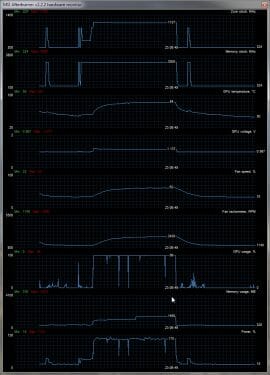
The two GeForce GTX 670s are identical in this test:
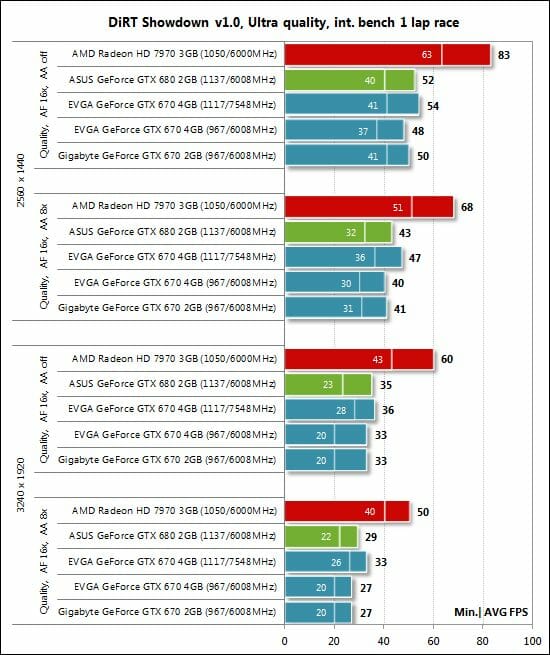
Sniper Elite V2 Benchmark
This is the most resource-consuming application on our list. It needs 1.3 gigabytes even at 2560×1440 without antialiasing and 2 gigabytes with 4x MSAA. After switching to 3240×1920, it needs 1.8 and 2.85 GB of graphics memory with antialiasing off and on, respectively.
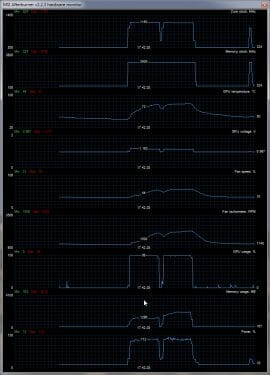
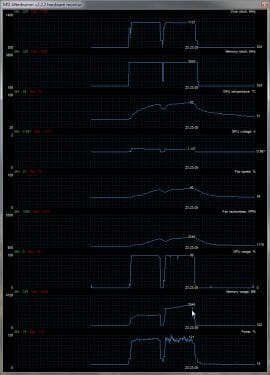
However, our GeForce GTX 670s only differ at the highest resolution:
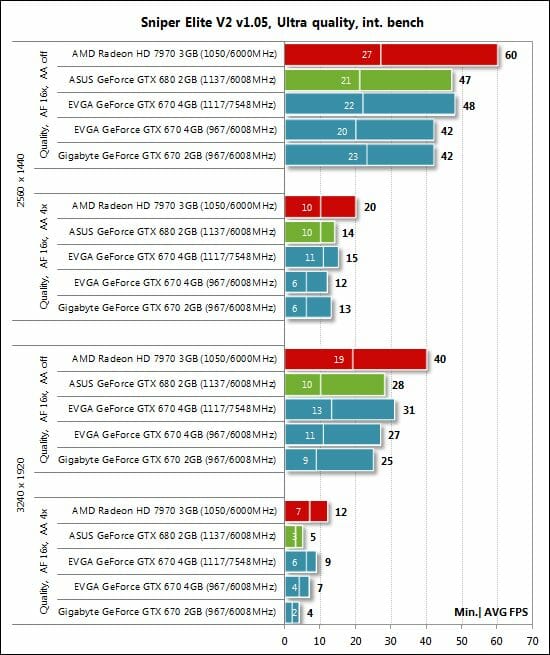
Although the EVGA is almost twice as fast as the Gigabyte, the frame rates are too low for comfortable play.
Here is a table with the complete test results for your reference:
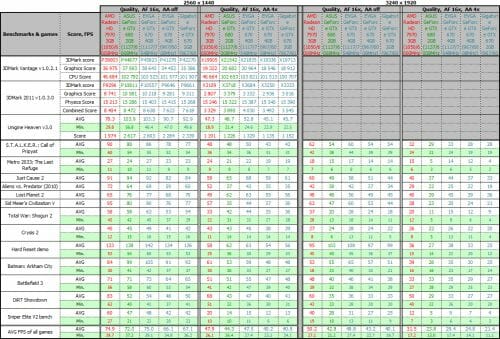
Conclusion
Increasing the amount of memory on board of GeForce GTX 670 and GTX 680 cards translates to obvious performance benefits only in specific unique cases, such as triple-monitor set-ups with 3240×1920 resolution and enabled antialiasing. Metro 2033: The Last Refuge and Sniper Elite V2 are the only games that need more than the standard 2 GB of graphics memory, but the contemporary High-End graphics cards are anyway too slow in these games even with 4 GB of video memory. In the rest of our games we could hardly see any difference between GeForce GTX 670s with 2 and 4 GB of memory in 3240×1920 and no difference at all in 2560×1440. So, purchasing a 4GB card wouldn’t be worth the investment unless you’ve got a triple-monitor configuration. But if you do have one, 4GB graphics cards really make sense for 2-, 3- and 4-way SLI configurations and playing contemporary games at high resolutions. In this case, the increased amount of memory would not become the bottleneck.
As for the particular product, the EVGA GeForce GTX 670 Superclocked+ 4GB is a well-made card that follows the reference design with minor modifications such as the shape of the vent grid and the increased GPU clock rate. By the way, EVGA played it safe with the GPU, which actually turned out to have much better overclocking potential. The memory chips could have also been overclocked to 6608 MHz, for example. The product definitely deserves high scores for its good accessories, handy software tools (Precision X and OC Scanner) and 3-year warranty.